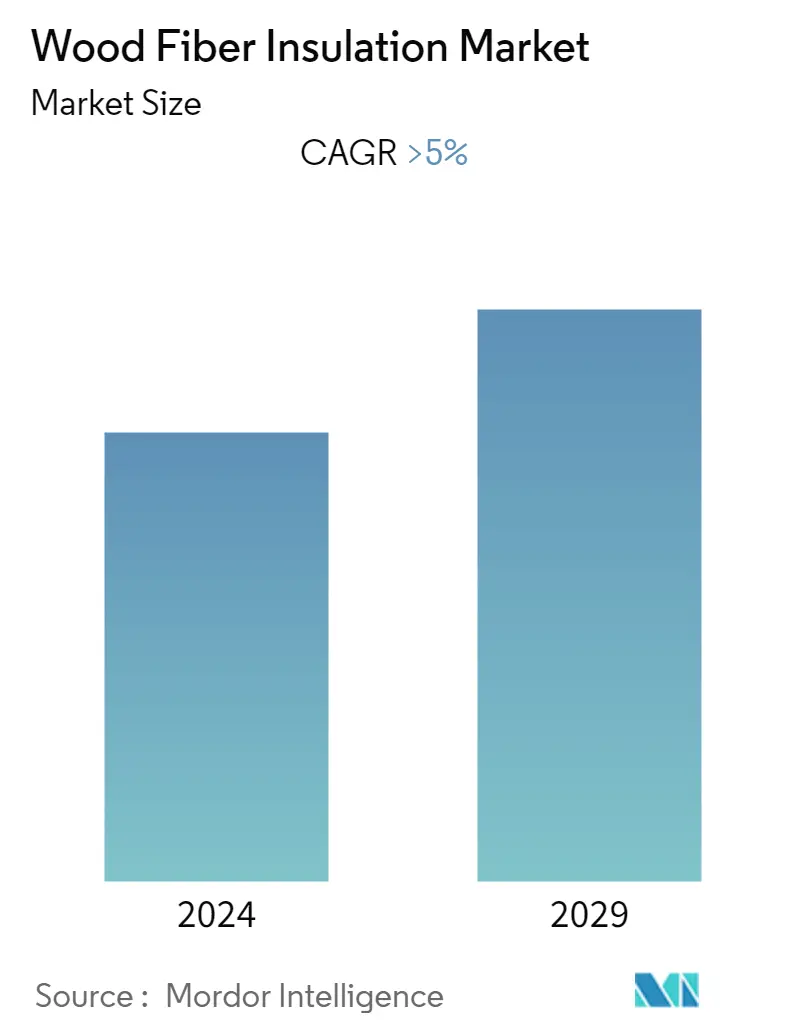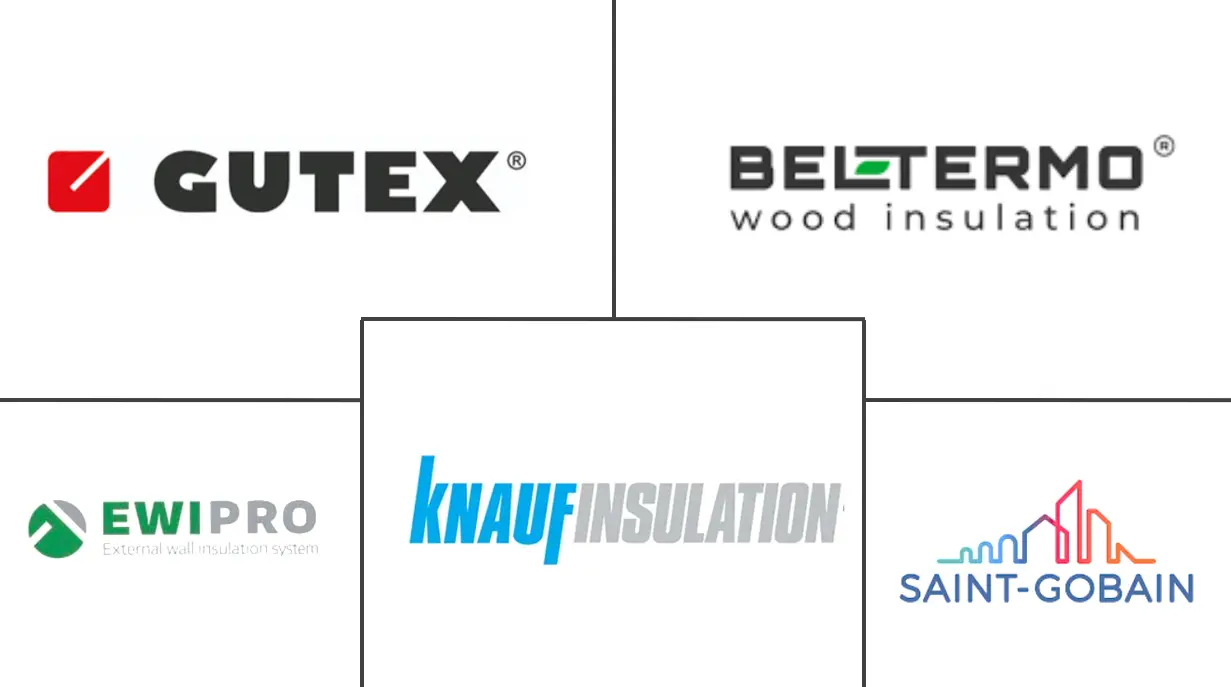Market Size of Wood Fiber Insulation Industry

| Study Period | 2019 - 2029 |
| Base Year For Estimation | 2023 |
| CAGR | > 5.00 % |
| Fastest Growing Market | Asia-Pacific |
| Largest Market | North America |
| Market Concentration | High |
Major Players
*Disclaimer: Major Players sorted in no particular order |
Wood Fiber Insulation Market Analysis
The wood fiber insulation market is projected to register a CAGR of over 5% during the forecast period.
During the COVID-19 epidemic, demand for wood fiber insulation increased significantly. It is due to a greater emphasis on home renovation projects as people spend more time at home. Furthermore, the rising demand for energy efficiency and sustainability increased the wood fiber insulation demand.
- In the short term, the increased demand for wood fiber insulation from the residential sector will likely boost market expansion. The growing need for energy-efficient buildings is predicted to fuel market expansion.
- However, the availability of alternative insulating materials such as fiberglass, cellulose, and foam hampered the growth of the wood fiber insulation business. Wood fiber insulation is much more expensive than other types of insulation.
- Nevertheless, future market growth is anticipated by the growing demand for energy-efficient and environmentally friendly insulating materials and an increased understanding of the environmental advantages of employing wood fiber insulation.
- Europe is expected to lead the market during the anticipated timeframe.
Wood Fiber Insulation Industry Segmentation
Wood fiber insulation is manufactured from wood fibers such as sawdust, wood chips, or wood shavings. It is commonly used to create thermal insulation and soundproofing in walls and ceilings. Because it is made from a renewable resource and is biodegradable, wood fiber insulation is an environmentally beneficial solution. It is also fire-resistant and can help you save money on energy. The wood fiber insulation market is segmented by application, end-user industry, and geography. The market is segmented by application into thermal, acoustic, and electric insulation. The end-user industry segments the market into residential, commercial, and institutional. The report also covers the market size and forecasts for 15 countries. For each segment, the market sizing and forecasts have been done based on value (USD Million).
| Application | |
| Thermal Insulation | |
| Acoustic Insulation | |
| Electrical Insulation |
| End-user Industry | |
| Residential | |
| Commercial | |
| Institutional |
| Geography | |||||||
| |||||||
| |||||||
| |||||||
| |||||||
|
Wood Fiber Insulation Market Size Summary
The wood fiber insulation market is experiencing a positive growth trajectory, driven by increasing demand for energy-efficient and sustainable building materials. The market is expected to expand significantly over the forecast period, with a notable surge in demand from the residential sector. This growth is largely attributed to the rising emphasis on home renovations and the need for energy-efficient buildings, which have gained traction during the COVID-19 pandemic. Despite the higher cost of wood fiber insulation compared to alternatives like fiberglass and foam, its environmental benefits and effectiveness in reducing energy costs are propelling its adoption. Europe is anticipated to lead the market, supported by stringent standards and a strong focus on sustainable construction practices.
In the residential construction sector, wood fiber insulation is gaining popularity due to its thermal efficiency and eco-friendly properties. It is increasingly used in various parts of homes, such as walls, attics, and ceilings, to enhance energy efficiency and reduce heating and cooling expenses. The market is also witnessing growth in the Asia-Pacific region, particularly in China, where government initiatives and subsidies are encouraging the use of energy-efficient materials. The European market benefits from established standards and a robust construction industry, with Germany playing a significant role. The market is consolidated, with major players like Saint-Gobain and Knauf Insulation leading the way, and recent expansions and acquisitions are further strengthening their market positions.
Wood Fiber Insulation Market Size - Table of Contents
-
1. MARKET DYNAMICS
-
1.1 Drivers
-
1.1.1 Increasing Demand from the Residential Sector
-
1.1.2 Growing Usage of Eco-friendly Insulation
-
-
1.2 Restraints
-
1.2.1 Availability of Several Insulation Materials
-
-
1.3 Industry Value-Chain Analysis
-
1.4 Porter's Five Forces Analysis
-
1.4.1 Bargaining Power of Suppliers
-
1.4.2 Bargaining Power of Buyers
-
1.4.3 Threat of New Entrants
-
1.4.4 Threat of Substitute Products and Services
-
1.4.5 Degree of Competition
-
-
-
2. MARKET SEGMENTATION (Market Size in Value)
-
2.1 Application
-
2.1.1 Thermal Insulation
-
2.1.2 Acoustic Insulation
-
2.1.3 Electrical Insulation
-
-
2.2 End-user Industry
-
2.2.1 Residential
-
2.2.2 Commercial
-
2.2.3 Institutional
-
-
2.3 Geography
-
2.3.1 Asia-Pacific
-
2.3.1.1 China
-
2.3.1.2 India
-
2.3.1.3 Japan
-
2.3.1.4 South Korea
-
2.3.1.5 Rest of Asia-Pacific
-
-
2.3.2 North America
-
2.3.2.1 United States
-
2.3.2.2 Canada
-
2.3.2.3 Mexico
-
-
2.3.3 Europe
-
2.3.3.1 Germany
-
2.3.3.2 United Kingdom
-
2.3.3.3 Italy
-
2.3.3.4 France
-
2.3.3.5 Rest of Europe
-
-
2.3.4 South America
-
2.3.4.1 Brazil
-
2.3.4.2 Argentina
-
2.3.4.3 Rest of South America
-
-
2.3.5 Middle East & Africa
-
2.3.5.1 Saudi Arabia
-
2.3.5.2 South Africa
-
2.3.5.3 Rest of Middle East & Africa
-
-
-
Wood Fiber Insulation Market Size FAQs
What is the current Wood Fiber Insulation Market size?
The Wood Fiber Insulation Market is projected to register a CAGR of greater than 5% during the forecast period (2024-2029)
Who are the key players in Wood Fiber Insulation Market?
EWI Pro Insulation Systems Ltd, GUTEX, Saint-Gobain , Knauf Insulation and Beltermo Wood Insulation are the major companies operating in the Wood Fiber Insulation Market.

